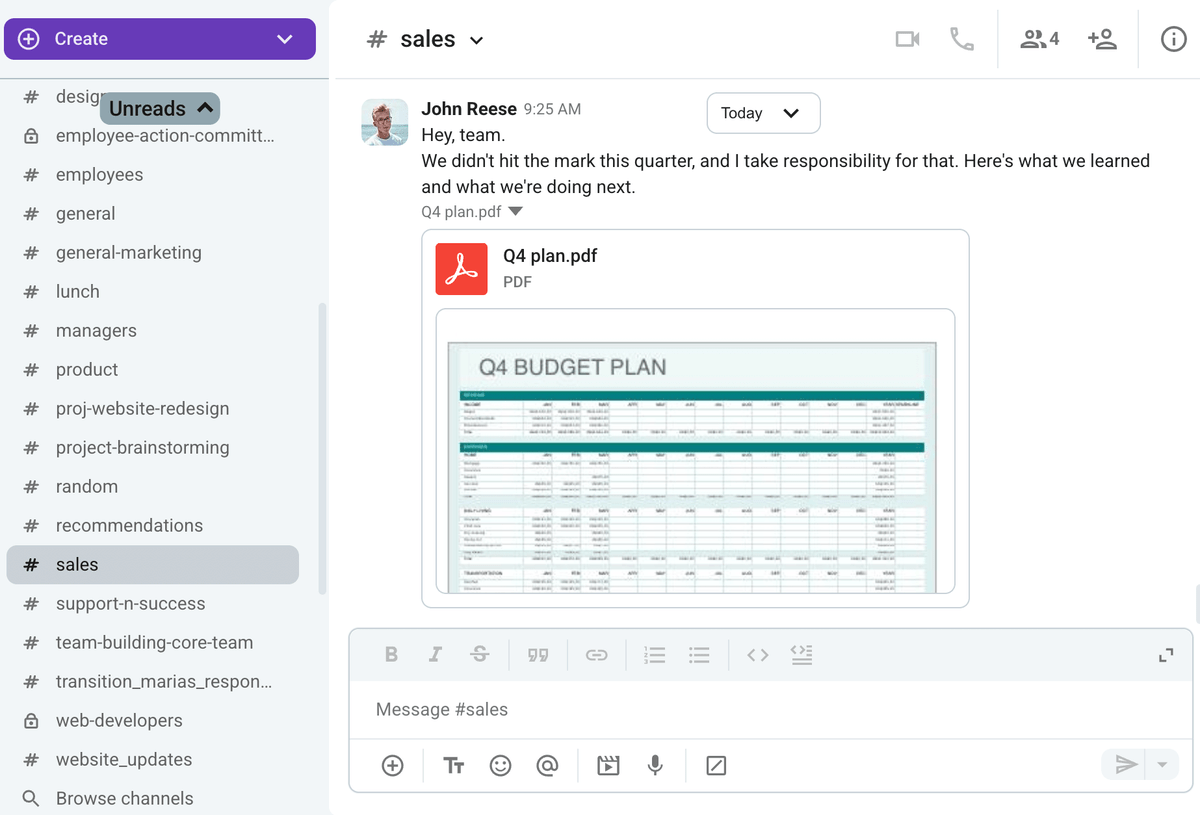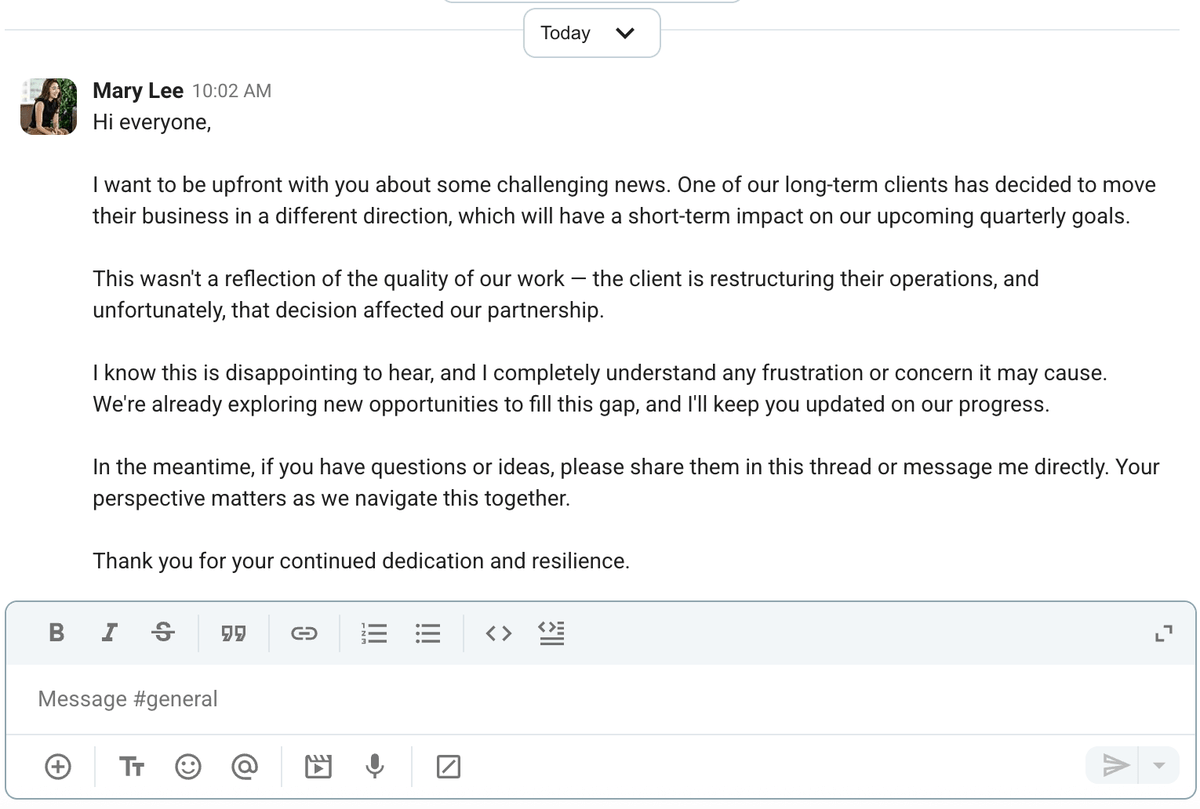Executives are often the most important channels of communication for both external and internal audiences.
As a leader, you are the face of your organization and a direct reflection of your brand. Everything you say and do carries immense weight and consequences.
Executive communication is a type of organizational communication that comes from the executive team — or, in other words, communication from the top.
It is not just another soft skill to adopt, it’s the single most powerful lever a leader has to shape culture, drive alignment, and build a high-performing organization.
This article will help you:
- See the real impact of both effective and poor executive communication,
- Understand the 4 pillars that make executive communication effective, and
- Learn how to improve your executive communication with practical steps for handling the most critical moments.
Let’s dive in.

Table of Contents
The data-backed case for prioritizing executive communication
Effective executive communication isn’t just a nice-to-have — it directly influences employee trust, engagement, and overall business performance.
According to Gallup’s 2023 research, only 21% of US employees strongly agree that they trust their organization’s leadership — and the consequences of this lack of trust are real.
When communication from the top is unclear or inconsistent, employees disengage, productivity drops, and turnover rises.
Gallup’s State of the Global Workplace: 2024 Report shows that disengaged employees cost the world an unbelievable $8.9 trillion in lost productivity, proving the importance of executive communication and just how expensive it can be when managed poorly.
On the other hand, when you invest in your leadership communication skills and communicate with clarity and purpose, the payoff is substantial.
According to The State of Business Communication 2024 report, 64% of business leaders and 55% of knowledge workers believe that effective communication increases team productivity. Similarly, organizations with highly engaged employees experience 43% lower turnover, as found in the 2024 Employee Engagement Report.
Communication from the top has a ripple effect across every level of the organization. It drives measurable business results, helping team members stay aligned, motivated, and connected to the company’s goals.
Connect with your team on Pumble
The 4 pillars of high-impact executive communication
If you want to practice effective executive communication, there are a few nonnegotiable principles that should become part of your everyday leadership routine.
#1 Authenticity
Audiences can spot dishonesty a mile away. Using self-serving language or sugarcoating what’s really going on is the fastest way to lose credibility with your employees and stakeholders.
In fact, according to the 2025 Edelman Trust Barometer, as many as 68% of respondents believe business leaders purposely lie and exaggerate.
To avoid being seen as dishonest, always choose authenticity and openness — even when it feels uncomfortable.
Being human and vulnerable doesn’t make you seem weak, it shows your team they can trust you to tell the truth.

#2 Clarity
Getting lost in corporate rhetoric is never a good way to lead your communication efforts. You need to cut through the noise with simple, direct messaging that gives people exactly what they need to know.
Communicate with clarity — be as specific as you can so everyone understands your message, intentions, and goals.
Interestingly, according to the latest report from Axios HQ, 83% of leaders believe their communication is clear and engaging, yet only 47% of employees agree. That gap shows how easily leaders can overestimate how their messages land.

Clarity is about saying what matters — sending too many messages that lack substance only leads to information overload and fatigue.
On the other hand, not sharing enough creates uncertainty and mistrust, as employees turn to speculation or unreliable sources to fill in the gaps.
Lead with clarity using Pumble
#3 Empathy
Research shows that empathy may be the single most important leadership skill in today’s world.
True empathy starts with understanding the context and perspective of the people you’re trying to reach. Before you communicate, take a moment to consider what your audience might be thinking, feeling, or worrying about.
By showing empathy, you:
- Strengthen relationships with your team,
- Foster a healthy company culture, and
- Boost employee engagement by helping people feel seen and valued.
Empathy also makes everything you say sound more genuine — because it is. When you’re whole-heartedly behind the message you’re delivering, people will see that you care.

#4 Consistency
As a leader, the best way to ensure your communication is well received is by being consistent.
If you send mixed messages, skip updates, or shift priorities without explanation, employees will become confused, unsure of what matters most, and may even lose trust in your leadership.
By consistently highlighting priorities, values, and expectations, employees will naturally align their actions with them.

Start by identifying the key messages you want your organization to understand, and share them regularly across different channels — meetings, group messages, or internal newsletters.
Whenever you provide updates or make decisions, tie them back to those core points, so employees can see continuity in your thinking and understand how each action contributes to the bigger picture.
Ensure consistency across channels
A playbook for critical leadership moments
Knowing the principles of high-impact communication is one thing, executing them when it counts is another.
Here are a few critical leadership moments you might face, and how to handle them effectively.
Communicating vision and strategy
As a leader, communicating your company’s vision isn’t just about sharing plans — it’s about shaping belief.
A poorly articulated vision will only lead to confusion, disengagement, and uncertainty.
In this moment, your goal is to translate strategy into meaning — to show where the organization is headed and why it matters.
To do this effectively:
- Start with the facts to eliminate ambiguity early.
- Clearly outline priorities and explain what actions are being taken.
- Create space for questions and feedback.
- Stay consistent with sharing updates regularly and following up on commitments.
Don’t over-reassure, it can easily come off as false optimism and make your employees feel disconnected. Instead, lead with calm confidence and transparent communication to build lasting trust.
Share updates effortlessly in Pumble
Leading through change or crisis
Change can be unsettling — especially for those who aren’t part of the decision-making process.
When your company is facing a crisis or experiencing major change, keeping employees well-informed and up-to-date is critical.
If you fail to do so, confusion and misunderstandings will quickly take over.
When communicating company changes:
- Be honest and open — this is when transparency is needed most.
- Share as much information as you can and do it in a clear, straightforward way.
- Listen to questions and concerns and take them seriously.
- Follow-up regularly with answers, updates, and reassurance.
Remember, in these times you’re not just a messenger for change. You’re the leader your team looks to for clarity, honesty, and stability.
Don’t just share information — offer support, comfort, and perspective. Let your team see that you’re facing the challenge alongside them and turn uncertainty into trust.
💡 PUMBLE PRO TIP
Navigating through a crisis can be challenging. To learn more about how to prepare and find your way through a difficult situation, read our guides on the topic:
Delivering difficult news
No matter how much you try to avoid it, delivering difficult news will always be part of your executive responsibilities.
Whether it’s losing a major client, letting someone go, or announcing a tough organizational decision, how you communicate the news can either preserve trust or break it.
As with all other executive communications, you should be following the 4 pillars you’ve built your framework on — but in these moments, pay special attention to empathy:
- Be direct but never harsh — honest communication is your only path forward.
- Share as much context as possible about how or why a decision was made.
- Listen to your employees and validate their thoughts and emotions. A strong reaction is natural — your role is to stay open and compassionate.
- Follow through keeping all relevant parties updated as the situation develops.

Don’t let bad news spread on its own. After informing the people directly affected, communicate promptly with the rest of the team or organization to prevent rumors, miscommunication or resentment.
Master modern executive communication with Pumble
A leader’s influence is only as strong as the tools that support it. Traditional channels like email are slow, formal, and often one-way — limiting how authentic and responsive a leader can be.
Modern leadership, however, requires modern infrastructure. That foundation is easily provided by a robust business communication app like Pumble by CAKE.com.
Pumble gives you a space to clearly and consistently communicate with your entire organization, strengthening trust at every level with ease.
With Pumble’s video and voice messages, leaders can share quick, unscripted updates that feel much more personal and human than a polished corporate email.
Company-wide announcement channels and Q&As in threaded conversations make communication transparent, giving employees room to engage and be listened to.

And because Pumble offers unlimited message history, every update, announcement, or decision becomes part of a permanent, searchable record your team can come back to anytime.
Use a tool that supports your leadership efforts and helps you communicate with authenticity and impact.







